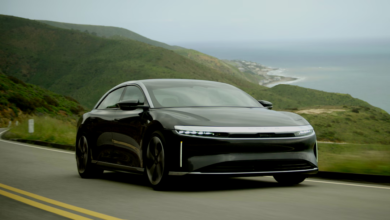The Future of Self-Driving Cars: How Close Are We to Full Autonomy? Technology
Self-driving cars autonomy? the future of autonomous vehicles, their challenges, benefits, and the road ahead in this in-depth analysis.

Self-driving cars, once a futuristic concept, are now a tangible reality, inching closer to full autonomy with each passing year. The idea of vehicles navigating without human intervention has captivated engineers, policymakers, and consumers alike. However, the journey toward fully autonomous vehicles is fraught with technological, ethical, and regulatory challenges. This article explores the current state of self-driving technology, the hurdles that remain, and the potential impact of autonomous vehicles on society, the economy, and the environment.
The concept of self-driving cars is not new. For decades, scientists and engineers have envisioned a world where vehicles operate independently, reducing human error and improving road safety. Today, companies like Tesla, and Uber are at the forefront of this revolution, testing and deploying autonomous vehicles in various capacities. Despite significant advancements, full autonomy—where a car can operate without any human input under all conditions—remains elusive. This article delves into the complexities of achieving full autonomy, examining the technological innovations, regulatory frameworks, and societal implications that will shape the future of self-driving cars.
The Current State of Self-Driving Technology
Self-driving cars rely on a combination of advanced technologies, including artificial intelligence (AI), machine learning, sensors, and high-definition mapping. These systems work together to enable a vehicle to perceive its environment, make decisions, and navigate safely. Most autonomous vehicles today operate at Level 2 or Level 3 autonomy, as defined by the Society of Automotive Engineers (SAE). At Level 2, the car can control steering and acceleration but requires constant human supervision. Level 3 vehicles can handle most driving tasks in specific conditions but still need human intervention when the system encounters a scenario it cannot manage.
Companies like Tesla have made significant strides with their Autopilot and Full (FSD) features, which offer advanced driver-assistance systems (ADAS). However, these systems are not fully autonomous and require drivers to remain attentive at all times. Waymo, a subsidiary of Alphabet, has taken a different approach by developing fully autonomous taxis that operate in geofenced areas. These vehicles, classified as Level 4 autonomy, can operate without human intervention but are limited to specific geographic regions and conditions.
The development of self-driving technology has also spurred innovation in sensor technology. Lidar (Light Detection and Ranging) sensors, radar, and cameras are critical components of autonomous systems. Lidar, in particular, has emerged as a key technology for creating detailed 3D maps of a vehicle’s surroundings. However, the high cost of Lidar sensors has been a barrier to widespread adoption. Companies are working to reduce costs and improve the reliability of these sensors, which are essential for achieving full autonomy.
Despite these advancements, significant challenges remain. One of the biggest hurdles is ensuring the safety and reliability of autonomous systems. cars must be able to navigate complex and unpredictable environments, including adverse weather conditions, construction zones, and interactions with human drivers and pedestrians. Achieving this level of reliability requires extensive testing and validation, which is both time-consuming and expensive.
Technological Challenges to Full Autonomy
Achieving full autonomy—Level 5 on the SAE scale—requires overcoming several technological challenges. One of the most significant is developing AI systems capable of handling edge cases, or rare and unpredictable scenarios. For example, how should acar respond if a pedestrian suddenly steps into the road or if another vehicle runs a red light? These situations require split-second decision-making and a deep understanding of human behavior, which is difficult to replicate in machines.
Another challenge is improving the robustness of sensor systems. While Lidar, radar, and cameras provide a wealth of data, they are not infallible. Adverse weather conditions, such as heavy rain or snow, can impair sensor performance, making it difficult for the vehicle to perceive its environment accurately. Researchers are exploring ways to enhance sensor reliability, including the development of multi-sensor fusion systems that combine data from multiple sources to create a more comprehensive picture of the vehicle’s surroundings.
The computational power required to process the vast amounts of data generated by autonomous systems is another hurdle. Self-driving cars rely on powerful onboard computers to analyze sensor data and make real-time decisions. These systems must be both highly efficient and capable of operating under extreme conditions, such as high temperatures or vibrations. Advances in edge computing and quantum computing may offer solutions to these challenges, enabling faster and more efficient data processing.
Cybersecurity is also a critical concern. As self-driving cars become more connected, they are increasingly vulnerable to cyberattacks. Hackers could potentially take control of a vehicle’s systems, posing a significant risk to passenger safety. Ensuring the security of autonomous systems requires robust encryption, secure communication protocols, and continuous monitoring for potential threats.
Finally, the development of high-definition maps is essential for the success of self-driving cars. These maps provide detailed information about road layouts, traffic signs, and other critical features, enabling vehicles to navigate more accurately. However, creating and maintaining these maps is a complex and resource-intensive process. Companies are exploring ways to automate map updates using data collected from fleets of autonomous vehicles, but this approach is still in its early stages.
Regulatory and Ethical Considerations
The widespread adoption of self-driving cars will require significant changes to existing regulatory frameworks. Governments around the world are grappling with how to regulate autonomous vehicles, balancing the need for innovation with the imperative to ensure public safety. In the United States, the National Highway Traffic Safety Administration (NHTSA) has issued guidelines for the testing and deployment of self-driving cars, but there is no comprehensive federal legislation governing their use. Instead, regulation is largely left to individual states, leading to a patchwork of laws and standards.
Ethical considerations also play a crucial role in the development of self-driving technology. One of the most debated issues is the “trolley problem,” a thought experiment that poses a moral dilemma: Should a self-driving car prioritize the safety of its passengers or pedestrians in the event of an unavoidable accident? Resolving this question requires input from ethicists, policymakers, and the public, as the decisions made will have far-reaching implications for the design and deployment of autonomous systems.
Privacy is another concern. Self-driving cars generate vast amounts of data, including information about their passengers’ locations, driving habits, and even biometric data. Ensuring the privacy and security of this data is essential to gaining public trust. Companies must implement robust data protection measures and be transparent about how they collect, store, and use this information.
Liability is another complex issue. In the event of an accident involving a self-driving car, who is responsible—the manufacturer, the software developer, or the passenger? Current liability laws are not equipped to handle these scenarios, and new frameworks will need to be developed to address these challenges.
Societal and Economic Impact
The widespread adoption of self-driving cars has the potential to transform society in profound ways. One of the most significant benefits is the potential to reduce traffic accidents, which are often caused by human error. According to the World Health Organization, over 1.3 million people die in road traffic crashes each year. Autonomous vehicles, with their ability to react faster and more accurately than humans, could significantly reduce this number.
Self-driving cars could also improve mobility for individuals who are unable to drive, such as the elderly or disabled. By providing a safe and reliable means of transportation, autonomous vehicles could enhance the quality of life for millions of people and reduce social isolation.
The economic impact of self-driving cars is equally significant. The automotive industry is poised to undergo a major transformation, with traditional manufacturers competing with tech companies to develop autonomous systems. This shift could lead to the creation of new jobs in areas such as software development, data analysis, and cybersecurity. At the same time, it could disrupt existing industries, such as trucking and ride-hailing, potentially leading to job losses in these sectors.
The environmental impact of self-driving cars is another important consideration. Autonomous vehicles have the potential to reduce greenhouse gas emissions by optimizing driving patterns and reducing traffic congestion. However, the increased energy consumption of onboard computing systems and the potential for higher vehicle miles traveled due to greater convenience could offset these benefits. Policymakers and industry leaders must work together to ensure that the transition to autonomous vehicles is environmentally sustainable.
The Road Ahead
While significant progress has been made in the development of self-driving technology, full autonomy remains a distant goal. Achieving this milestone will require continued innovation, collaboration, and investment. Companies must address the technological challenges that remain, while governments and policymakers must create regulatory frameworks that support the safe and responsible deployment of autonomous vehicles.
Public acceptance is also critical to the success of self-driving cars. Many people remain skeptical of autonomous technology, citing concerns about safety, privacy, and job displacement. Building trust will require transparency, education, and a commitment to addressing these concerns.
The future of self-driving cars is full of promise, but it is not without its challenges. As we move closer to full autonomy, it is essential to consider the broader implications of this technology and ensure that it benefits society as a whole. By working together, we can create a future where self-driving cars are not only a reality but also a force for good.
Read More: How to Stay Motivated Even When Things Get Difficult 2023
Conclusion
The journey toward full autonomy for self-driving cars is a complex and multifaceted one, requiring advancements in technology, regulation, and societal acceptance. While significant progress has been made, challenges such as ensuring safety, addressing ethical dilemmas, and building public trust remain. The potential benefits of autonomous vehicles—ranging from improved road safety to enhanced mobility for underserved populations—are immense, but realizing these benefits will require continued collaboration and innovation.
As we look to the future, it is clear that self-driving cars have the potential to transform our world in profound ways. However, this transformation must be guided by a commitment to safety, equity, and sustainability. By addressing the challenges head-on and working together, we can create a future where self-driving cars are not only a reality but also a positive force for society. The road to full autonomy may be long, but with determination and collaboration, we can navigate it successfully.
FAQs
What is the current level of self-driving technology?
Most self-driving cars today operate at Level 2 or Level 3 autonomy, requiring human supervision. Level 4 autonomy, which allows full autonomy in specific conditions, is being tested in limited areas.
What are the main challenges to achieving full autonomy?
Key challenges include handling edge cases, improving sensor reliability, ensuring cybersecurity, and developing high-definition maps.
How will self-driving cars impact jobs?
While autonomous vehicles could create new jobs in tech and data analysis, they may also disrupt industries like trucking and ride-hailing, potentially leading to job losses.
Are self-driving cars safe?
Self-driving cars have the potential to reduce accidents caused by human error, but ensuring their safety in all conditions remains a significant challenge.
What role do governments play in the development of self-driving cars?
Governments must create regulatory frameworks that balance innovation with public safety, address liability issues, and ensure data privacy and security.







